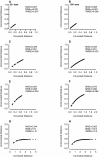Mega-phylogeny approach for comparative biology: an alternative to supertree and supermatrix approaches
- PMID: 19210768
- PMCID: PMC2645364
- DOI: 10.1186/1471-2148-9-37
Mega-phylogeny approach for comparative biology: an alternative to supertree and supermatrix approaches
Abstract
Background: Biology has increasingly recognized the necessity to build and utilize larger phylogenies to address broad evolutionary questions. Large phylogenies have facilitated the discovery of differential rates of molecular evolution between trees and herbs. They have helped us understand the diversification patterns of mammals as well as the patterns of seed evolution. In addition to these broad evolutionary questions there is increasing awareness of the importance of large phylogenies for addressing conservation issues such as biodiversity hotspots and response to global change. Two major classes of methods have been employed to accomplish the large tree-building task: supertrees and supermatrices. Although these methods are continually being developed, they have yet to be made fully accessible to comparative biologists making extremely large trees rare.
Results: Here we describe and demonstrate a modified supermatrix method termed mega-phylogeny that uses databased sequences as well as taxonomic hierarchies to make extremely large trees with denser matrices than supermatrices. The two major challenges facing large-scale supermatrix phylogenetics are assembling large data matrices from databases and reconstructing trees from those datasets. The mega-phylogeny approach addresses the former as the latter is accomplished by employing recently developed methods that have greatly reduced the run time of large phylogeny construction. We present an algorithm that requires relatively little human intervention. The implemented algorithm is demonstrated with a dataset and phylogeny for Asterales (within Campanulidae) containing 4954 species and 12,033 sites and an rbcL matrix for green plants (Viridiplantae) with 13,533 species and 1,401 sites.
Conclusion: By examining much larger phylogenies, patterns emerge that were otherwise unseen. The phylogeny of Viridiplantae successfully reconstructs major relationships of vascular plants that previously required many more genes. These demonstrations underscore the importance of using large phylogenies to uncover important evolutionary patterns and we present a fast and simple method for constructing these phylogenies.
Figures



Similar articles
-
The impact of HGT on phylogenomic reconstruction methods.Brief Bioinform. 2014 Jan;15(1):79-90. doi: 10.1093/bib/bbs050. Epub 2012 Aug 20. Brief Bioinform. 2014. PMID: 22908214
-
Phylogenetic supermatrix analysis of GenBank sequences from 2228 papilionoid legumes.Syst Biol. 2006 Oct;55(5):818-36. doi: 10.1080/10635150600999150. Syst Biol. 2006. PMID: 17060202
-
The challenge of constructing large phylogenetic trees.Trends Plant Sci. 2003 Aug;8(8):374-9. doi: 10.1016/S1360-1385(03)00165-1. Trends Plant Sci. 2003. PMID: 12927970 Review.
-
Inferring the mammal tree: Species-level sets of phylogenies for questions in ecology, evolution, and conservation.PLoS Biol. 2019 Dec 4;17(12):e3000494. doi: 10.1371/journal.pbio.3000494. eCollection 2019 Dec. PLoS Biol. 2019. PMID: 31800571 Free PMC article.
-
From famine to feast? Selecting nuclear DNA sequence loci for plant species-level phylogeny reconstruction.Philos Trans R Soc Lond B Biol Sci. 2006 Jan 29;361(1465):211-25. doi: 10.1098/rstb.2005.1735. Philos Trans R Soc Lond B Biol Sci. 2006. PMID: 16553318 Free PMC article. Review.
Cited by
-
OpenTree: A Python Package for Accessing and Analyzing Data from the Open Tree of Life.Syst Biol. 2021 Oct 13;70(6):1295-1301. doi: 10.1093/sysbio/syab033. Syst Biol. 2021. PMID: 33970279 Free PMC article.
-
The PIN-FORMED (PIN) protein family of auxin transporters.Genome Biol. 2009;10(12):249. doi: 10.1186/gb-2009-10-12-249. Epub 2009 Dec 29. Genome Biol. 2009. PMID: 20053306 Free PMC article. Review.
-
Does a plant-eating insect's diet govern the evolution of insecticide resistance? Comparative tests of the pre-adaptation hypothesis.Evol Appl. 2017 Dec 18;11(5):739-747. doi: 10.1111/eva.12579. eCollection 2018 Jun. Evol Appl. 2017. PMID: 29875815 Free PMC article.
-
C4 photosynthesis promoted species diversification during the Miocene grassland expansion.PLoS One. 2014 May 16;9(5):e97722. doi: 10.1371/journal.pone.0097722. eCollection 2014. PLoS One. 2014. PMID: 24835188 Free PMC article.
-
Identifying and addressing methodological incongruence in phylogenomics: A review.Evol Appl. 2023 Jun 6;16(6):1087-1104. doi: 10.1111/eva.13565. eCollection 2023 Jun. Evol Appl. 2023. PMID: 37360032 Free PMC article. Review.
References
-
- Bininda-Emonds ORP, Cardillo M, Jones KE, MacPhee RDE, Beck RMD, Grenyer R, Price SA, Vos RA, Gittleman JL, Purvis A. The delayed rise of present-day mammals. Nature. 2007;446:507–512. - PubMed
-
- Driskell AC, Ané C, Burleigh JG, McMahon MM, O'meara BC, Sanderson MJ. Prospects for building the tree of life from large sequence databases. Science. 2004;306:1172–1174. - PubMed
-
- Ciccarelli FD, Doerks T, Mering C, Creevey CJ, Snell B, Bork P. Toward automatic reconstruction of a highly resolved tree of life. Science. 2006;311:1283–1287. - PubMed
-
- McMahon MM, Sanderson MJ. Phylogenetic supermatrix analysis of GenBank sequences from 2228 papilionoid legumes. Systematic Biology. 2006;55:818–836. - PubMed
-
- Chase MW, Soltis DE, Olmstead RG, Morgan D, Les DH, Mishler BD, Duvall MR, Price RA, Hills HG, Qui YL, Kron KA, Rettig JH, Conti E, Palmer JD, Manhart JR, Sytsma KJ, Michael HJ, Kress WJ, Karol KG, Clark WD, Hedren M, Gaut BS, Jansen RK, Kim KJ, Wimpee CF, Smith JF, Furnier GR, Strauss SH, Xiang QY, Plunkett GM, Soltis PS, Swensen SM, Williams SE, Gadek PA, Quinn CJ, Eguiarte LE, Golenberg E, Learn GH, Jr, Graham SW, Barrett SCH, Dayanandan S, Albert VA. Phylogenetics of seed plants: an analysis of nucleotide sequences from the plastid gene rbcL. Annals of the Missouri Botanical Garden. 1993;80:528–580.
Publication types
MeSH terms
Substances
LinkOut - more resources
Full Text Sources
Other Literature Sources

